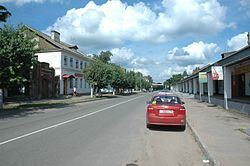Administrative district Gdovsky District Urban settlement Gdov Urban Settlement | Administrative center of Gdovsky District Local time Saturday 12:56 PM | |
 | ||
Municipal district Gdovsky Municipal District Weather 3°C, Wind S at 6 km/h, 87% Humidity | ||
Gdov (Russian: Гдов; Estonian: Oudova) is a town and the administrative center of Gdovsky District in Pskov Oblast, Russia, located on the Gdovka River, just 2 kilometers (1.2 mi) from its outflow into Lake Peipus. Population: 4,379 (2010 Census); 5,171 (2002 Census); 6,009 (1989 Census).
Contents
- Map of Gdov Pskov Oblast Russia 181600
- History
- Administrative and municipal status
- Industry
- Transportation
- Military installations
- Restricted access
- Culture
- References
Map of Gdov, Pskov Oblast, Russia, 181600
History
It was first mentioned in the beginning of the 14th century, as an outpost guarding the city of Pskov. Between 1431 and 1434, Pskovians built a fortress there, the remains of which can still be seen. It was attacked on numerous occasions by Swedes and Poles (e.g., during the Russo–Swedish War (1590–1595) and the Ingrian War), captured by Swedes in 1614, but was finally returned to Russia in 1617 according to the Treaty of Stolbovo.
In the course of the administrative reform carried out in 1708 by Peter the Great, Gdov was included into Ingermanland Governorate (known since 1710 as Saint Petersburg Governorate). Gdov was mentioned as one of the towns into which the governorate was divided. In 1780, Gdov was granted town status; its coat of arms was granted on May 28, 1781. Between 1874 and 1912, Gdov issued Zemstvo stamps. The first stamp, worth two kopecks, appeared on April 16, 1874. Stamp production ceased, however, with the coming of World War I. In 1919, Gdov was an area where important events of the Russian Civil War and the Estonian War of Independence were taking place. Originally, the area east of Lake Peipus was under control of the revolutionary government. On May 15, 1919, the detachment under command of Stanisław Bułak-Bałachowicz (subordinate to General Aleksandr Rodzyanko) captured Gdov and the whole uyezd thus came under control by the White Army troops of Nikolai Yudenich. In November 1919, the Red Army recaptured Gdov.
On August 1, 1927, the uyezds and governorates were abolished and Gdovsky District, with the administrative center in Gdov, was established as a part of Luga Okrug of Leningrad Oblast. It included parts of former Gdovsky Uyezd. On July 23, 1930, the okrugs were also abolished and the districts were directly subordinated to the oblast. Between March 22, 1935 and September 19, 1940, Gdovsky District was a part of the restored Pskov Okrug of Leningrad Oblast, one of the okrugs abutting the state boundaries of Soviet Union. Between July 19, 1941 and February 4, 1944, Gdov was occupied by German troops. The town was seriously damaged during the war but partially restored afterwards. On August 23, 1944, the district was transferred to newly established Pskov Oblast.
Administrative and municipal status
Within the framework of administrative divisions, Gdov serves as the administrative center of Gdovsky District, to which it is directly subordinated. As a municipal division, the town of Gdov, together with sixty-two rural localities, is incorporated within Gdovsky Municipal District as Gdov Urban Settlement.
Industry
The economy of Gdov is based on food and timber industries.
Transportation
A railway connects Gdov via Slantsy with Veymarn. Originally, the railway connected Pskov with Veymarn. It was destroyed during World War II and the stretch between Gdov and Pskov was never rebuilt.
Gdov is connected by roads with Pskov, Kingisepp via Slantsy, and Plyussa. There are also local roads, with bus traffic originating from Gdov.
Military installations
An active military base, Smuravyevo, was located northeast of the town.
Restricted access
Gdov is included into border security zone, intended to protect the borders of Russia from unwanted activity. In order to visit the zone, a permit issued by the local FSB department is required.
Culture
Gdov contains two cultural heritage monuments of federal significance and additionally twelve objects classified as cultural and historical heritage of local significance. The federal monuments are archaeological sites. Gdov has a kremlin, an ancient fortress built in the 14th century. Only fragments of the original fortress walls have survived. The St. Dimitry Cathedral was destroyed in 1944 and reconstructed in the 1990s.
The only state museum in the district is the Museum of Gdov Region History. It was founded in 1919, destroyed during the German occupation of Gdov, and re-created after World War II. The museum hosts historical and local interest collections.
